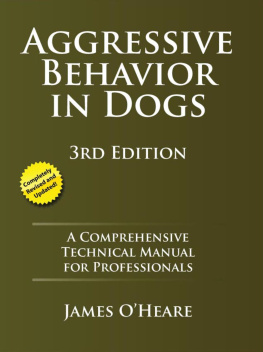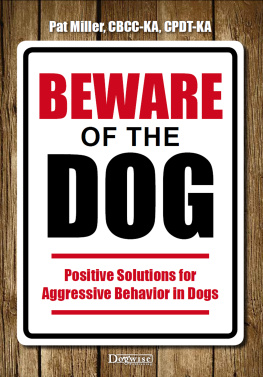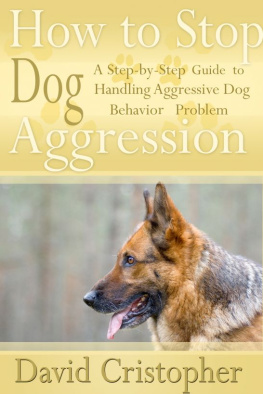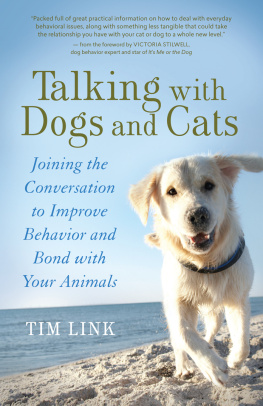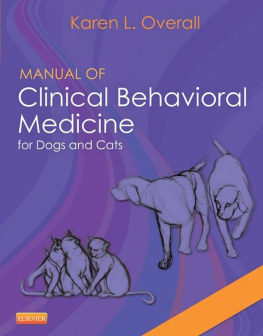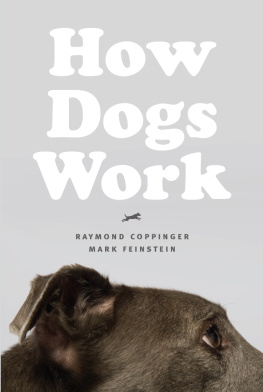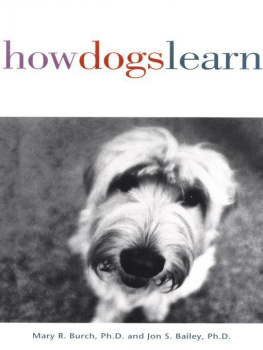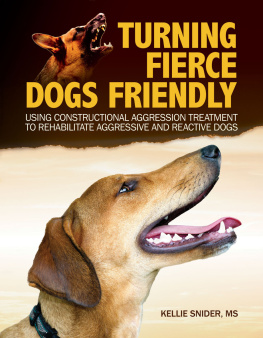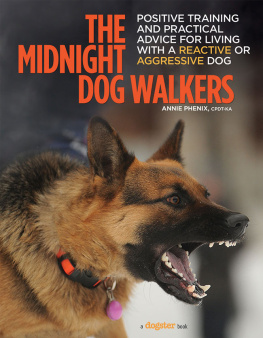Aggressive Behavior in Dogs
James OHeate
3rd Edition
BehaveTech Publishing
Ottawa Canada
Copyright 2017 by James OHeare. All rights reserved. No part of this book may be reproduced or transmitted in any form or by any means, electronic or mechanical, including photocopying, recording, or by an information storage or retrieval system, without permission in writing from the author.
Title: Aggressive Behavior in Dogs: 3rd edition
Publisher: BehaveTech Publishing, Ottawa Canada.
www.BehaveTech.com
Author: James OHeare
Cover art and book design: James OHeare
Illustrator: Jaq Bunn
Limits of Liability and Disclaimer of Warranty:
The author shall not be liable in the event of incidental or consequential damages or loss in connection with, or arising out of the furnishing, performance, or use of the instructions or suggestions contained in this book. This book provides information of a general nature. Working with dogs can be risky.
ISBN 978-1-927744-16-1
I dedicate this book to all of the nonhuman animals who are brutalized by speciesist humans.
TABLE OF CONTENTS
Aggressive Behavior in Dogs, Third Edition is a comprehensive technical manual for behaviorologists and professional behavior technologists addressing working through cases involving aggressive behaviors exhibited by dogs. It addresses managing aggressive behavior cases, the prevention of aggressive behavior, functional behavioral assessment of aggressive behavior, and the systematic construction and implementation of contingency management plans to resolve them.
Since this is a technical manual, I make use of appropriate terminology. For help with unfamiliar terms, use the Association of Animal Behavior Professionals Glossary at:
http://www.associationofanimalbehaviorprofessionals.com/glossary.html
The currently titled book Dog Aggression Workbook (likely titled Aggressive Behavior in DogsWorkbook for the next edition) was written as a complement to this manual, so that professionals can provide clients with reading materials to make their relationship more efficient.
Thank you to my Professor, and now colleague, at The International Behaviorology Institute where I attained my Doctoral Certificate in Behaviorology, Dr. Stephen Ledoux. My behaviorology repertoire expansion experience induces pride related behaviorsa very additively reinforcing experience. I would also like to thank Lawrence Fraley for interesting discussion and inspiration. Finally, thank you to students and faculty at the Companion Animal Sciences Institute, who provide stimulation discussion on a daily basis, which I benefit from greatly. In particular, thank you Bill Weiler and Vernessa Eadie for helping find typos and Kamrin MacKnight for proofreading. Any remaining errors are likely the result of my stubborn declining of what was probably good advice.
1. What is aggressive behavior, and why do dogs exhibit such behavior?
2. How can aggressive behavior be prevented?
3. How can aggressive behavior-related cases be assessed in a systematic way that implies the appropriate resolution strategies?
4. How can a systematic and scientifically sound contingency management plan be constructed to meet the formal behavior objectives and resolve the problem?
This manual will address these four key questions in detail. First, I would like to provide some broad contextual remarks.
In most western cultures, dogs are now predominantly family members. In a study by Barker and Barker (1984, discussed in Newby, 2001), in which participants were asked to diagram their significant relationships, more than one-third of the participants drew the family dog closer to themselves than any other family member. When a dog is considered a family member, people are prepared to sacrifice time, energy, and other resources to maintain this close familial relationship. In the past, if a dog exhibited behavior that might be characterized as aggressive, he or she might simply be discarded. These days, when dogs behave in an aggressive manner, we are less inclined to simply dispose of them, preferring to expend the resources necessary to resolve the problem. When technologists help clients resolve problematic aggressive behaviors, they are not merely making the clients life easier or saferthey are intervening to help resolve extremely important family relationships. This is a very important role, which should prompt us to take it extremely seriously.
Part 1 addresses the scope of the aggressive behavior problems as well as the role of the behaviorologist or animal behavior technologist in working with clients whose dogs exhibit such behavior.
Does society really have an aggressive behavior problem with dogs? If so, how big a problem is it? If the problem is, in reality, not as frequent or severe as is commonly believed, why is it seen otherwise? Is the perspective different for society, guardians, and behavior technologists? In this chapter, I examine these questions so that we can proceed with our exploration of aggressive behaviors in dogs in a rational and grounded fashion.
In her book, Dogs Bite: But Balloons and Slippers are More Dangerous, Bradley (2005) provides a critical analysis of statistical and methodological aspects of the most frequently cited studies on the prevalence of dog bites. Many of these studies would have us believe that aggressive behaviors are a major and increasing problem in society. Bradley shows, through her strong analysis of the research, that, far from being a major societal problem, aggressive behavior in dogs has a relatively minor impact in terms of cost and injuries. The mantra of the book is the reality now is that dogs almost never kill people, and they dont actually bite very often, and when they do, were seldom injured, and when we are, its seldom serious (p. 30).
So, how dangerous are dogs? According to Bradleys (2005, p. 15) research, dogs are not as dangerous as front-porch steps, kitchen utensils, five-gallon water buckets, bathtubs, strollers, stoves, lamp cords, coffee-table corners, Christmas trees, balloons, or bedroom slippers. Your chance of being killed by a dog, Bradley explains, is approximately one in 18 million, which means that you are twice as likely to win the Super Lotto jackpot or five times more likely to be killed by a bolt of lightning. In the United States, children under 10 are killed by caregivers approximately 826 times per year, by buckets 22 times per year, by playgrounds 15 times per year, by balloons 11 times per year, and by dogs approximately 10 times per year. Car accidents kill 43,730 people per year, accidental falls kill 14,440, accidental poisoning kills 14,142, and even bicycles kill 774 people per year, compared with dogs, who kill 16 people per year. For injuries, Bradley reports 7,714,167 caused by falls, 3,990,652 by cars, 3,366,270 by overexertion, 909,688 by other bites, and 504,627 by bicycles, compared with a mere 340,784 by dogs. More people are hurt each year by slippers, sneakers, other shoes, tables, chairs, beds, and doors, than by dogs.
And when it comes to severity of dog bites, Bradley (2005) reports that the vast majority (92.4%) cause no actual injury, while 7.5% cause minor injury and a meager 0.076% cause moderate to serious injury. Accidental falls cause far more serious and costly injuries, and, in the domestic animal category, horses cause far more medically treated injuries or deaths than dogs. Even cows cause more deaths than dogs. Taken together, the statistics Bradley present paint a picture of the aggressive behavior problem that is vastly different from many peoples conceptualization. On a given day, being injured or killed by a dog is vastly less probable than dozens of other potential hazards that we rarely, if ever, become concerned about.

